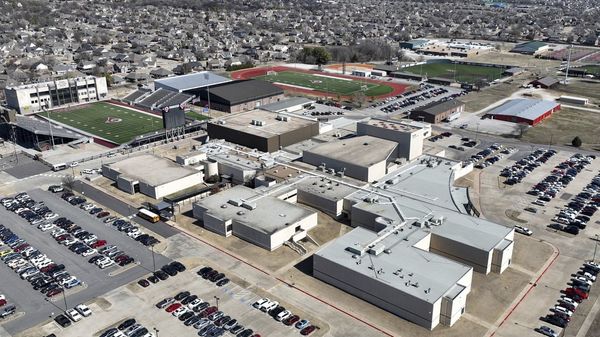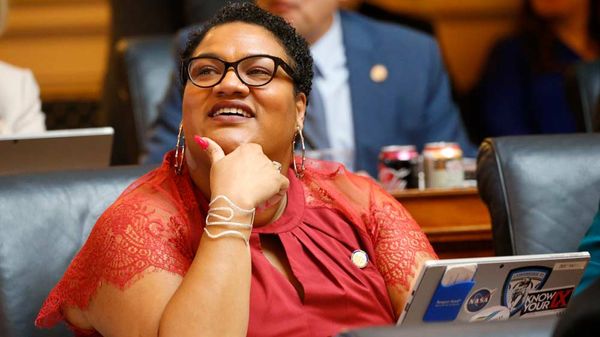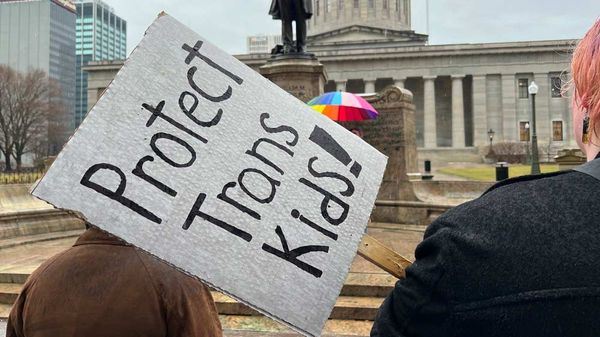July 13, 2009
At 54, Cleve Jones Is Ready for His 'Comeback'
Steve Weinstein READ TIME: 4 MIN.
Cleve Jones is happy. As happy as he has ever been, thank you. He has a labor union job he loves, powerful allies in Hollywood and Washington, guys to date. Best of all, a new generation of gay activists has embraced him as the mentor he once had, the man whose story he helped deliver to the screen in the movie "Milk."
Call it a cultural confluence, call it a comeback. Now 54 and the closest the gay rights movement has to a living legend, the former protege to a political martyr and creator of the AIDS Memorial Quilt is busily planning his next act - a march on the nation's capital that he hopes will usher in the final era in his community's struggle for acceptance.
"There was a time when I thought I would never be happy again," Jones says, standing barefoot in the tiki-torched yard of the California desert bungalow where he has lived since 1999 but is rarely home long enough to enjoy. "I feel so connected to the movement again."
That he feels compelled to comment on his good fortune says a lot about the twists Jones' own life took after 1978, the year openly gay San Francisco Supervisor Harvey Milk was assassinated.
Culture watchers will remember that Jones, the 23-year-old City Hall intern portrayed in "Milk," went on to create the 47,000-panel quilt that humanized the lives lost to AIDS. Less widely known is that during the decade he spent weaving one of the world's largest folk art projects into the nation's fabric, Jones was preparing to die himself.
Instead, he became one of the AIDS epidemic's earliest survivors.
"If I'd known I was going to live this long, I would have saved money and joined a gym," laughs Jones, who shows the puckish sense of humor actor Emile Hirsch exhibited as his on-screen alter-ego.
When talk turns to the National Equality March scheduled for the second week of October in Washington, however, Jones turns serious.
His goal is to build an army of activists drawn from each of the nation's 435 congressional districts. Afterward, participants will be sent home to pressure their representatives and the White House into removing the remaining barriers to gay equality, such as the policy that prevents gays from serving openly in the military.
If successful, Jones' vision would represent a sea change in the gay rights movement's strategy of securing victories piecemeal on the local or state level.
"We got locked into this pattern of fighting for fractions of crumbs - 'Oh please, sir, in this county could we please not be fired for being gay if it's all right in this county for you to evict us for being gay?'" he says. "It's been this ping-pong with our basic civil rights....If you are a free and equal people, why would you settle for this?"
Jones agreed to organize the march at the urging of veteran activist David Mixner, who proposed it as a way to lobby President Barack Obama to follow through on his campaign promises.
"When he has a sense of righteousness about a mission, he has a tenacity I have rarely seen," said Mixner, who has known Jones since the 1970s. "He is not a person who has ever put himself before the mission."
Many gay leaders quickly dismissed the march idea as a waste of time and money. Jones took to the Internet and the gay political circuit to address the nay-sayers.
During more than 35 years of activism, friends and associates say that Jones has weathered criticism before.
In 1986, when he was trying to amass support for a giant quilt stitched by people who lost loved ones to AIDS, even fellow activists refused to get on board, according to Jones. Many saw the project as a morbid endeavor that would distract them from the serious work of persuading the government to invest in AIDS research.
Jones persisted. The NAMES Project AIDS Memorial Quilt is now recognized as not only a powerful symbol of loss, but a turning point in the public's perception of the disease.
"I thought who is going to grieve the most when I die? It's going to be my family - my parents, my little sister and my grandmothers. I wanted a place in this movement for my grandmothers," he says.
With his health waning, Jones in 1990 relinquished control of the quilt to a nonprofit foundation that eventually moved the 54-ton quilt to Atlanta. He continued to serve as its public face until five years ago, when tensions between him and the foundation's new leadership bubbled over with his firing and an unsuccessful wrongful termination suit.
In recent years, Jones has worked as a gay community liason for the national hotel workers union, an outgrowth of his activism.
He credits Milk, the middle-aged camera store owner turned politician, with transforming him from a shy and somewhat aimless young hippie into a committed activist unafraid to use his voice or to be open about his sexuality.
"Harvey was never a shadow to me. He was an inspiration, a light. His biggest gift to me was to not fear straight people," he said.
Jones' determination not to let Milk's legacy fade was key in getting the movie made, said screenwriter Dustin Lance Black, who won an Oscar for his work on the film. Jones served as the movie's historical adviser.
"Cleve never lost his belief in the power of the grass roots," Black says. "I remember when I first met him, over those first few years of research and even when shooting 'Milk' he would say, 'What is your generation doing? I can't imagine how empty it must be not to have a really strong generational purpose.'"
In Jones, Black sees an heir to Milk's role as an inspirational leader. "Milk" opened last November just before the 30th anniversary of Milk's assassination and just after California voters passed a ballot measure rescinding the right to wed the state Supreme Court had granted gays five months earlier.
For weeks, young activists protested in major cities across the country.
"I saw this man's eyes light up in a way I had never seen," Black says of Jones. "I saw him come to life when the young people started to rise up. I think he recognized in them a purpose he hadn't seen since his own days with Harvey Milk."
Steve Weinstein has been a regular correspondent for the International Herald Tribune, the Advocate, the Village Voice and Out. He has been covering the AIDS crisis since the early '80s, when he began his career. He is the author of "The Q Guide to Fire Island" (Alyson, 2007).







